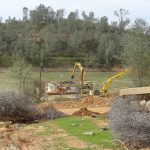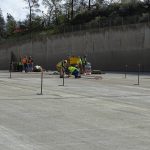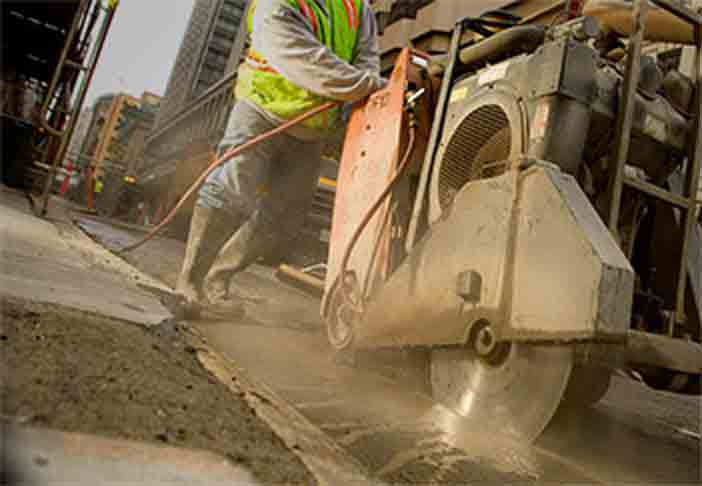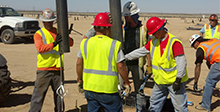Managing a Crisis
Syblon Reid, LIUNA Local 185 Show Power of Teamwork on Oroville Dam Emergency Project
In the western foothills of the Sierra Nevada mountains in Northern California’s Butte County, the tallest earthen dam structure in the U.S. – Oroville Dam – soars 770-feet high, offering a birds-eye view of the surrounding area as far as the eye can see. Directly behind it lies the picturesque expanse of Lake Oroville, California’s second largest manmade reservoir. Impounded by the dam and fed by the Feather River watershed, the lake is capable of storing over 3.5 million acre feet of water and supplies an estimated 23 million Californians with drinking water and irrigation water to nearly one million acres of farmland.
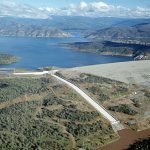
Oroville Dam and Lake, prior to failure of the spillway. Photo courtesy of CA Department of Water Resources.
Together, Oroville Dam, Lake Oroville and the adjacent Edward Hyatt Hydroelectric Powerplant represent a key component of the California State Water Project. They provide critical flood control, water storage, recreation, hydroelectric power generation and water quality improvements for the Sacramento-San Joaquin River Delta region.
Until recently, perhaps the most noticeable daily occurrences in this otherwise bucolic location were the churning turbines at Hyatt Powerplant converting water into clean, usable power; the roar of water cascading over Oroville Dam’s flood control spillway; and perhaps the coming and going of visitors eager to explore the lake’s abundant and diverse recreational offerings.
Since mid-February, however, there has been a whole different type of activity taking place at the Oroville Dam. It involves the nonstop movement of heavy construction equipment, trucks and helicopters hauling materials on and off site and the buzz of dozens of construction crews working around-the-clock. Their mission: to complete an emergency repair project to Oroville Dam’s flood control and emergency spillways, restore the power plant to operation, and strengthen the flood control spillway structure enough so that a longer-term fix can be put in place before next season’s rains.
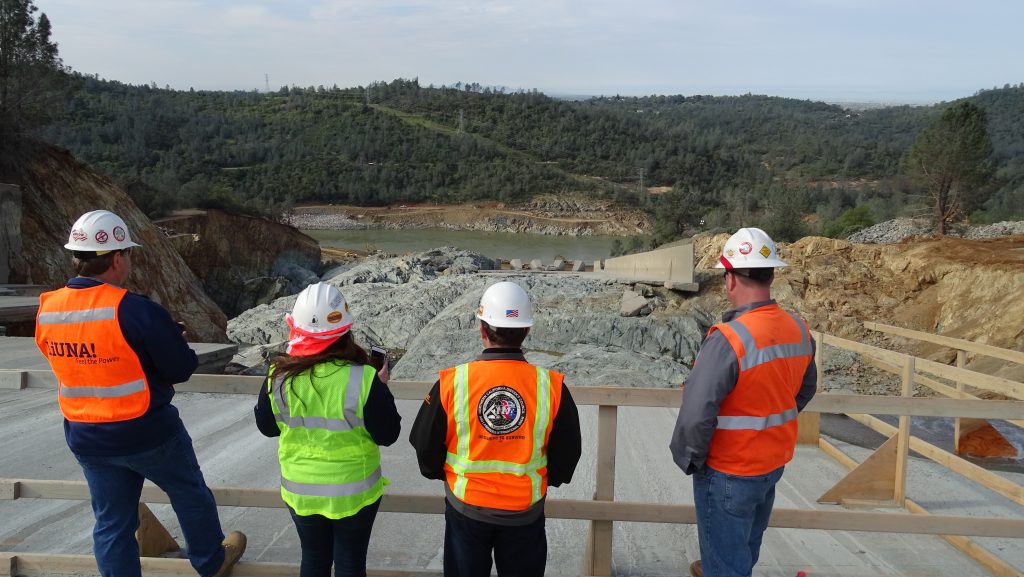
LIUNA Vice President and Regional Manager Rocco Davis, LIUNA TriFund Coordinator Amber Novey, LIUNA International Representative Izaak Velez and Syblon Reid Senior Manager Will Scott look over the end of the damaged spillway.
Project owner the Department of Water Resources (DWR) contracted with general engineering contractor Syblon Reid Construction to take on the emergency job. Syblon Reid in turn contracted with a host of additional subcontractors and material suppliers, and working together along with local craftspeople – including dozens from Laborers Local 185 – the entire team delivered a project that is a testament to the can-do spirit and know-how of the construction industry and the strength of the local labor pool. It illustrates what can be accomplished when a coordinated team of well-qualified contractors, backed by a capable, trained local workforce, work together to achieve a common goal.
A Call to Action
The Oroville Dam emergency project became a necessity in early February, when inspectors with the Department of Water Resources (DWR) first noticed damage to the flood control spillway at Oroville Dam. Weeks of record-setting rainfall had taken their toll, filling Lake Oroville to capacity and requiring significant releases of water from the flood control spillway into the Feather River below.
The DWR knew they needed a contractor that could be counted on in an emergency – one they had worked with many times before and that could handle a project this fluid and complex. They reached out to Syblon Reid Construction Company for help. The Folsom-based contractor has a long track record completing projects for the DWR and many other public owners and is known for its quality work throughout the west. It takes pride in its logo: “Providing solutions to difficult projects.”
Syblon Reid’s Vice President and Operations Manager, Spencer Frederickson, received the call from DWR at 6 p.m. Monday evening, February 6th, to mobilize a team to provide an analysis and recommendation for repair on the hole that had developed on the flood control spillway. “Syblon Reid had staff onsite within two hours, and have been working there 24/7 ever since February 7th,” Frederickson said.
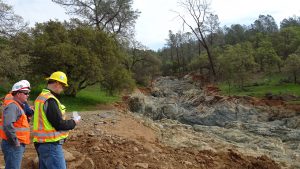
Syblon Reid Senior Manager Will Scott, on left, and Industrial Relations Manager Bill Koponen survey the aftermath of the erosion caused by use of the emergency spillway.
Will Scott, a Senior Manager for Syblon Reid, was appointed jobsite manager of the emergency repair operation at Oroville Dam. Under his direction, Syblon Reid has orchestrated a highly complex, dynamic emergency repair effort involving many moving parts and up to 500 total individuals onsite at peak construction, ranging from DWR officials and inspectors to contractors and subcontractor personnel and the many craftspersons and laborers who physically put the work in place.
Tackling a Difficult Job
In the early days and weeks of the project, a variety of events and challenges expanded the repair effort and made completion a moving target, requiring constant flexibility and the ability to devise new solutions quickly. As Syblon Reid mobilized on site, they initially developed a plan to bring rock and concrete in to fill the hole in the flood control spillway, with the hope that the auxiliary (emergency) spillway would not need to be used. As the rain continued to pound the area over the next few days and the lake level continued to rise, however, it quickly became apparent that the emergency spillway would likely be pressed into service for the first time in the dam’s 49-year history.
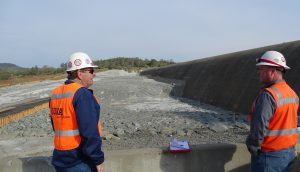
Syblon Reid Senior Manager Will Scott, on right, discusses the work being performed at the emergency spillway with LIUNA Vice President and Regional Manager Rocco Davis.
The risk was that water flowing down the slopes below the emergency spillway could also entrap a large amount of debris with it and deposit it into the Feather River, which then continues on through the city of Oroville. So, in addition to bringing in rock and materials to shore up and temporarily fix the flood control spillway, crews also worked to clear trees and other vegetation from the hillside below the auxiliary spillway and then armor it with concrete and rock.
As flows down the flood control spillway were increased to lower the lake level, the damage to that spillway grew. Debris that had already been swept into the river from the flood control spillway and the threat of water backing up into the Hyatt hydroelectric plant that sits at the base of the Oroville Dam quickly forced the temporary closure of the plant.
Bringing More Contractors on Board
Syblon Reid contracted and coordinated with several additional contractors in an effort to dredge the channel downstream of the powerhouse. They needed to excavate sediment in the river in order to lower the water surface elevation in the river and alleviate the flooding at Hyatt. Additional contractors came on board to perform various components of the work that was required, including Lund Construction, Ballard Marine Construction, Nordic/Great Lakes and Teichert Construction.
On Saturday February 11th, 2017, water began flowing over the top of the Oroville emergency spillway for the first time ever. Erosion at the base of that spillway progressed faster than expected. The erosion threatened to undermine and collapse the emergency spillway and to flood downstream communities. Officials ordered widespread evacuations of an estimated 180,000 people on February 12th, an order that reduced to a warning by the 14th when residents were allowed back home.
Contractors and crews continued to work feverishly to prevent the powerplant from flooding. To achieve that, Syblon Reid and its crews performed an array of tasks, a few of which included:
– Rapid fabrication and installation of bulkheads for the turbine draft tubes to isolate the powerhouse and prevent flooding;
– Providing mechanical support to maintain operation of the fixed cone valves and gates at the downstream diversion dam;
– Multiple bays plumbed to headers, leading to sumps in the powerhouse;
– Fabrication of a new header that ran down to a 3,000-gallon storage tank near unit 6; and much more.
Syblon Reid also performed a variety of work designed to seal joints and cracks within the main spillway; drilled and installed 36 post tensioned #14 bar rock anchors in the spillway slab; and a wide array of other work to date.
The contractor expects to complete this emergency repair project in late spring or early summer, according to Scott. A separate contract released by DWR will enact a more permanent repair to the spillway. That contract was recently awarded to Keiwit Construction and is expected to be completed before the next rainy season begins.
Fast Mobilization of Equipment and Materials
Accomplishing the wide array of emergency work needed on this project demanded that Syblon Reid and other contractors assemble equipment and materials in very short order. Among the major materials moved on- or offsite for this project were:
– Large 6 ton quarry stones for slope stabilization
– 25,000 yards of concrete placed
– 150,000 tons of rock (much of it excavated/reused from the adjacent Feather River)
– Over 1.5 million yards of debris removed from the river.
The assembled equipment arsenal for this project included:
– 6 mobile fabrication trucks and 3 more F450s to support millwright operations
– 3 water trucks
– 55 off-road articulated rock trucks
– 17 dozers of various size
– 156 road graders
– 31 total excavators including six long reach excavators on land and another 6 off barges
– 5 cranes
– 4 helicopters
– 3 concrete 50+ meter pump trucks
– 60 concrete trucks delivering 250 cubic yards of concrete per day at peak placement
– 180 rock trucks importing shot rock from seven different quarries
– 4 barge assemblies and additional boars
– 86 light plants to accommodate night work, which have illuminated the project from as far as 20 miles away to the town of Gridley.
Laborers Local 185 Steps Up
In addition to the assemblage of materials and equipment, the project’s success has depended in large part on the ability to assemble a capable, willing and ready workforce. Laborers Local 185 stepped up to the plate in a big way, providing Syblon Reid the workforce it needed quickly and efficiently.
“Right from the start Local 185 leadership and members did an outstanding job staffing and performing on the project,” commented Syblon Reid Industrial Relations Director Bill Koponen. “Nights, weekends, whatever was needed their teamwork, partnership and professionalism enabled us to respond to the emergency needs of our client under difficult circumstances. Challenges like this don’t come along every day, and Local 185 was key to the success of this difficult and demanding project.”
All totaled, Local 185 supplied approximately 55 laborers in 65 days and counting (as of 4/18), tallying approximately 72,000 manhours to date and generating about $2 million in wages, according to Local 185 Rep John Flem. He noted that it has been a boon to the local economy and a true boost in the arm to local workers.
“We at Local 185 Laborers Hall are proud of the fact that we can man up any job, any location, anytime in these 20 counties with skilled craft laborers,” Flem said. “We are very aggressive in training our laborers to be well-rounded to have the ability and confidence to handle any situation successfully.”
Flem added, “I am especially proud of our laborers who handled this emergency on a dime’s notice. For example, Syblon Reid personally called me on a holiday (President’s Day) at 6:30 a.m. requesting 10 laborers ASAP for critical emergency work. We filled that job order in less than 45 minutes with top quality hands.”
Scott noted that the vast majority live in the immediate area and are truly invested in the success of the region. “Paychecks aside, there was a huge motivation (for laborers) to get up here and help. We’ve had very good success with the local response for the request for workers.”
Teamwork and Innovation Play Pivotal Roles
Beyond the sheer magnitude of equipment and manpower mobilization, perhaps the most critical driver behind the success on this project has been an innovative approach and a strong sense of teamwork among all the project participants.
“You have to be innovative on a project like this,” Scott said. That included everything from devising quick solutions to avoid water backing up in the turbines at the powerhouse, to armoring solutions for the emergency spillway, to daily review and revisal of trucking haul routes to accommodate the massive debris removal process.
“We had to pioneer roads to get to these haul routes and at the same time think about the future needs of the area,” Scott noted. Field leadership representing each of the key contractors participate every workday in twice daily planning sessions to discuss strategic mapping of debris removal and to brainstorm any other issues.
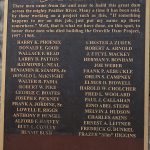
A plaque found at the top of the Oroville Dam commemorating the 34 construction workers that died during its construction from 1957 to 1968.
Maintaining a secure and safe worksite is something Syblon Reid prides itself on. The work that has been done throughout the construction site has reflected their commitment to keeping everyone safe. To date there have been no lost time incidents despite the 24/7 work schedule, according to Scott.
Ultimately, the biggest driver behind the success has been teamwork and the commitment to the same goal, Scott added. “The people and the contractors that we have out here want to be successful on their projects, and that’s why we called them here. Everyone is kind of working through this together, and everyone here is very committed to success.”






